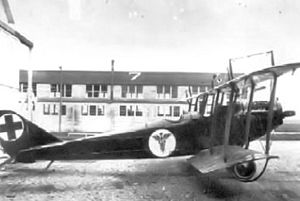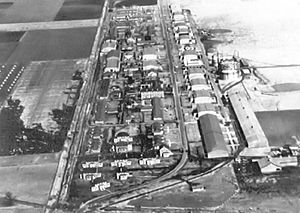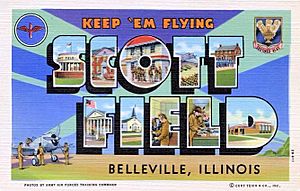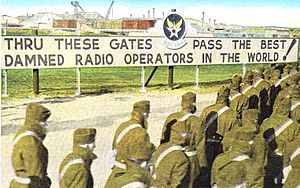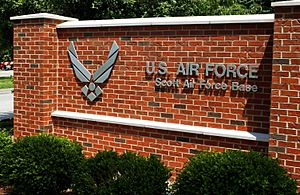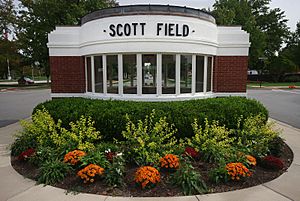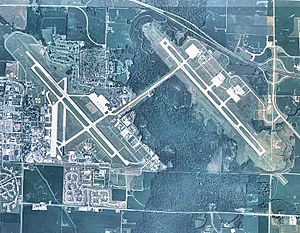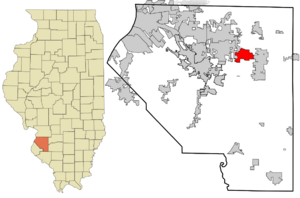Scott Air Force Base facts for kids
Quick facts for kids Scott Air Force Base |
|||||||||
|---|---|---|---|---|---|---|---|---|---|
| Near Belleville, Illinois in the United States of America | |||||||||

A C-40C Clipper of the 932nd Airlift Wing based at Scott AFB, seen during 2011
|
|||||||||
 |
|||||||||
| Coordinates | 38°32′N 89°52′W / 38.533°N 89.867°W | ||||||||
| Type | US Air Force base | ||||||||
| Site information | |||||||||
| Owner | Department of Defense | ||||||||
| Operator | US Air Force | ||||||||
| Controlled by | Air Mobility Command (AMC) | ||||||||
| Condition | Operational | ||||||||
| Site history | |||||||||
| Built | 1917 (as Scott Field) | ||||||||
| In use | 1917 – present | ||||||||
| Garrison information | |||||||||
| Current commander |
Colonel John Poole | ||||||||
| Garrison |
|
||||||||
| Airfield information | |||||||||
| Identifiers | IATA: BLV, ICAO: KBLV, FAA LID: BLV, WMO: 724338 | ||||||||
| Elevation | 459 ft (140 m) AMSL | ||||||||
|
|||||||||
Scott Air Force Base (IATA: BLV, ICAO: KBLV, FAA LID: BLV) is a big United States Air Force base. It is located in St. Clair County, Illinois, close to Belleville and O'Fallon. This base is about 17 miles (27 km) east of downtown St. Louis.
The base is home to the main offices of Air Mobility Command (AMC). This command helps move people and supplies for the Air Force. It also hosts the U.S. Transportation Command. This group helps organize transportation for all parts of the U.S. military.
Scott Air Force Base has about 13,000 people working there. This includes 5,100 civilians and 5,500 active-duty Air Force members. Another 2,400 people are part of the Air National Guard and Reserve. In 2014, it was announced that two new cybersecurity groups would be added to the base.
The airfield at Scott Air Force Base is also used by civilian planes. This part is called MidAmerica St. Louis Airport. It has been a shared airport since 1997.
Contents
History of Scott Air Force Base
Starting in World War I
During World War I, the U.S. government wanted to build more airfields. Leaders from the St. Louis area wanted one of these new "flying fields" in their region. They worked together to find a good spot.
The U.S. War Department agreed to lease 624 acres of land on June 14, 1917. Congress gave $10 million to build the base. About 2,000 workers quickly started building. The base was named after Corporal Frank S. Scott. He was the first enlisted service member to die in an aviation crash. This happened in 1912.
Scott Field began training pilots in August 1917. The first flight from the field was on September 2, 1917. Flying lessons started soon after. By the end of the war in 1918, over 300 pilots and many ground crews had been trained there.
The main training plane was the Curtiss JN-4D "Jenny." Learning to fly was dangerous back then. So, the base needed a way to help pilots who crashed.
In 1918, some officers designed two "air ambulances." These were Jenny planes changed to carry injured pilots. On August 24, 1918, a pilot with a broken leg became the first patient flown out by air.
The local community strongly supported Scott Field. People came to watch the construction and planes. They also hosted dances and invited soldiers for Thanksgiving. The base also held sports events and air shows for the public. After the war, flying stopped, and the base became smaller. The War Department bought Scott Field in 1919.
Between the World Wars
After World War I ended in 1918, the future of Scott Field was unclear. Many airfields closed down. But in 1919, the War Department decided to buy Scott Field. Its central location and good price helped save it.
In 1921, Scott Field became a base for "lighter-than-air" (LTA) ships. These were balloons and airships. The Army Balloon and Airship School moved there. Airships were used to study aerial photography and weather. A huge airship hangar was built between 1921 and 1923. It was three blocks long and 15 stories high. The base also made its own hydrogen for the airships.
During this time, Scott Field set some records. In 1923, the TC-1 airship set a speed record of 74 mph (119 km/h). In 1927, Captain Hawthorne C. Gray set an American balloon altitude record of 28,510 feet (8,689 m).
By the mid-1930s, airplanes became more important than airships. After some airship accidents, the Army Air Corps decided to stop LTA activities. In June 1937, the airship era at Scott Field ended.
Scott Field's central location was still very useful. It was chosen as a possible new home for the General Headquarters Air Force. This group managed the combat part of the U.S. Army. The base grew from 628 acres in 1938 to 1,882 acres in 1939. Many old buildings were torn down. New housing, offices, and industrial buildings were built. This expansion continued into 1940. The buildings from this time are now part of the Scott Field Historic District.
World War II and Beyond
When World War II began, the plan to move the General Headquarters Air Force to Scott was canceled. Instead, Scott Field went back to being a training base. In September 1940, the Radio School opened.
During World War II, Scott's main job was to train skilled radio operators and mechanics. These graduates were called the "Eyes and Ears of the Army Air Forces." They flew in planes and helped with communications in every part of the war. By the end of the war, Scott's Radio School had grown very large. It had about 46 buildings and had trained 77,370 radio operators.
Scott was also planned to be a major air terminal. In 1940, a project started to build four long concrete runways. These runways helped train pilots in instrument flying, night flying, and navigation. Airfield operations were stopped for a while in 1944. This happened after a fire damaged Hangar 1, the base's only hangar. Repairs were finished in May 1945.
Becoming an Air Force Base
The U.S. Air Force became its own separate military branch on September 18, 1947. On January 13, 1948, Scott Field was renamed Scott Air Force Base. The Radio School was reorganized. Some courses moved to other bases, and Scott focused on radio mechanic training.
In 1949, the headquarters of Air Training Command (ATC) moved to Scott AFB. This command was in charge of training for the Air Force. Scott's mission of moving patients by air also grew. By 1950, planes were bringing 200 patients a week to Scott.
In 1957, the Military Air Transport Service (MATS) moved to Scott AFB. This group managed air transportation. Air Training Command then moved its headquarters to another base. Scott's main job became air mobility, which means moving people and supplies by air.
The mission of moving patients by air continued to be important. In 1964, the host wing at Scott was renamed the 1405th Aeromedical Transport Wing. In 1966, MATS became Military Airlift Command (MAC). The 375th Aeromedical Airlift Wing took over the patient transport mission. They added C-9A Nightingale planes in 1968. In 1973, Scott helped bring 357 former Vietnam War Prisoners of War back to the U.S. By 1975, the 375th was in charge of the worldwide aeromedical evacuation system.
In 1978, the 375th also started managing operational support airlift. This means flying smaller planes for official travel. The base received its first T-39A Sabreliner in 1962. Later, these planes were replaced by Gates C-21A Learjets in 1984.
In 1992, Military Airlift Command (MAC) was replaced by Air Mobility Command (AMC). In the 1990s, two new partners joined Scott. These were MidAmerica Airport and the Illinois Air National Guard 126th Air Refueling Wing. MidAmerica Airport opened in 1998, sharing the airfield with the base. The 126th Air Refueling Wing moved to Scott AFB in 1995.
In 2003, the C-9A Nightingale planes were retired. The C-21A fleet was also changed. Today, Scott uses different types of planes for patient transport, official travel, and air refueling.
On September 30, 2009, the 375th Airlift Wing became the 375th Air Mobility Wing. This change helped combine active duty Air Force members with the Air National Guard. They work together to fly and maintain KC-135R Stratotanker planes.
On June 25, 2014, Scott Air Force Base received two new cybersecurity squadrons. This added over 300 people and $16 million in improvements to the base.
Main Commands and Units
Scott Air Force Base has been home to many important commands and units over the years.
- Main Commands:
* Signal Corps, U.S. Army (1917) * United States Army Air Service (1918) * United States Army Air Corps (1926) * Air Training Command (1946) * Military Air Transport Service (1957) * Military Airlift Command (1966) * Air Mobility Command (1992 – present)
- Main Units:
* Army Balloon and Airship School (1922–1937) * Air Corps/AAF/USAF Technical School (1939–1959) * Headquarters, Air Training Command (1949–1957) * Headquarters, Military Air Transport Service (1958–1966) * Headquarters, Military Airlift Command (1966) * Headquarters, Air Mobility Command (1992 – present) * 932d Airlift Wing (Air Force Reserve Command) (1963 – present) * 375th Airlift Wing (1966 – present) * 126th Air Refueling Wing (Air National Guard) (1999 – present) * Eighteenth Air Force (2003 – present)
Units at Scott Air Force Base
Many different flying and non-flying units are based at Scott Air Force Base. Some units are "Geographically Separate Units" (GSUs). This means they are based at Scott but report to a parent unit somewhere else.
United States Air Force Units
- Air Mobility Command (AMC)
* Headquarters Air Mobility Command (This is the main office for AMC.) * Eighteenth Air Force (This group helps with mobility operations.) * 375th Air Mobility Wing (This is the main host wing for the base.) * It includes squadrons that fly C-40C Clipper and C-21A Learjet planes. * It also has a squadron that works with the KC-135R Stratotanker for refueling. * Other groups handle communications, medical care, and base support.
- Air Combat Command (ACC)
* Cyberspace Capabilities Center (This group works on cybersecurity.) * Sixteenth Air Force * 67th Cyberspace Wing (This wing has squadrons that work on cyberspace operations.) * 557th Weather Wing (This wing helps with weather information.)
- Air Force Materiel Command (AFMC)
* 635th Supply Chain Operations Wing (This wing manages supplies.)
- Air Force District of Washington
* The US Air Force Band of Mid-America (This is a military band.)
- Air Force Field Operating Agencies
* Air Force Manpower Analysis Agency (This agency studies how the Air Force uses its people.)
Air National Guard (ANG) Units
- Illinois Air National Guard
* 126th Air Refueling Wing (This wing flies KC-135R Stratotanker planes for air refueling.)
Air Force Reserve Command (AFRC) Units
- Twenty-Second Air Force
* 932nd Airlift Wing (This wing flies C-40C Clipper planes.)
- Tenth Air Force
* 960th Cyberspace Wing (This wing works on cyberspace operations.)
Civil Air Patrol (CAP) Units
- Illinois Wing
* Scott Composite Squadron (This is a local Civil Air Patrol unit.)
United States Army Units
- Surface Deployment and Distribution Command (SDDC)
* Headquarters Surface Deployment and Distribution Command (This group helps move Army equipment and supplies.)
Department of Defense Units
- United States Transportation Command (USTRANSCOM)
* Headquarters United States Transportation Command (This is the main office for USTRANSCOM, which coordinates transportation for all military branches.)
- Defense Information Systems Agency (DISA)
* DISA Global Operations Center East (This center helps with military communication systems.)
About the Base Area
The part of the base where people live is called a census-designated place. In 2010, about 3,612 people lived there.
The base covers an area of about 3.7 square miles (9.7 square kilometers). All of this area is land.
People Living on Base
In 2000, there were 2,707 people living on the base. Most households were married couples with children. The average household had about 3.8 people.
The population on base was quite young. About 44.7% of residents were under 18 years old. The average age was 22 years. Most people were White (78.9%), followed by Black or African American (13.5%). About 4.1% of the population was Hispanic or Latino.
The average income for a family on base was about $52,258. Only a small number of families (0.9%) lived below the poverty line.
Getting Around
Light Rail Trains
The Shiloh–Scott station connects Scott Air Force Base to MetroLink's Red Line. This train can take you directly to downtown St. Louis. You can buy tickets at the station. MetroLink trains also go to St. Louis Lambert International Airport and other nearby towns.
Bus Services
Several MetroBus lines serve Scott Air Force Base through the Shiloh–Scott station. These buses go to different areas like O'Fallon, Lebanon, and Mascoutah.
There are also special shuttle buses on the base. The SCCTD Flyer is a flexible bus service on the base. The MidAmerica Airport Shuttle connects the train station to the civilian airport terminal.
In Movies and TV
Scott Air Force Base has been featured in some movies:
- It was seen in the 2018 film Rampage.
- Scenes from the 2021 Netflix movie Don't Look Up were set at Scott Air Force Base.
Images for kids
See also
 In Spanish: Scott AFB para niños
In Spanish: Scott AFB para niños




